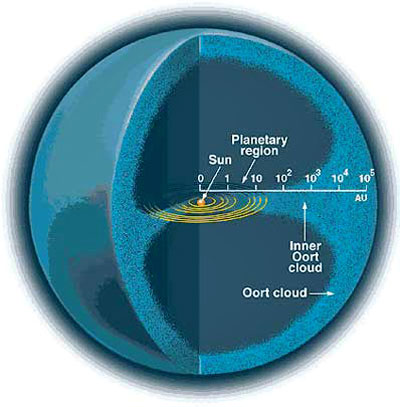|

by Charles Q. Choi
SPACE.com Contributor
01 December 2010
from
Space Website

Diagram
showing the position of the Oort Cloud.
CREDIT: Southwest Research Institute
Our sun may have a companion that
disturbs comets from the edge of the solar system - a giant planet
with up to four times the mass of Jupiter, researchers suggest.
A NASA space telescope launched last year may soon detect such a
stealth companion to our sun, if it actually exists, in the distant
icy realm of the comet-birthing Oort cloud, which surrounds our
solar system with billions of icy objects.
The potential jumbo Jupiter would likely be a world so frigid it is
difficult to spot, researchers said. It could be found up to 30,000
astronomical units from the sun. One AU is the distance between the
Earth and the sun, about 93 million miles (150 million km).
Most systems with stars like our sun - so-called class G stars -
possess companions. Only one-third are single-star systems like our
solar system.
Not a
nemesis
Scientists have already proposed that a hidden star, which
they call
"Nemesis," might lurk a light-year or so away from our sun.
They suggest that during its orbit, this
red dwarf or brown dwarf star would regularly enter the Oort cloud,
jostling the orbits of many comets there and causing some to fall
toward Earth. That would provide an explanation for what seems to be
a cycle of mass extinctions here.
Still, other astronomers recently found that if Nemesis did exist,
its orbit could not be nearly as stable as claimed. Now researchers
point to evidence that our sun might have a different sort of
companion.
To avoid confusion with the Nemesis model, astrophysicists John
Matese and Daniel Whitmire at the University of Louisiana
at Lafayette dub their conjectured object "Tyche" - the good sister
of the goddess Nemesis in Greek mythology, and a name proposed by
scientists working on NASA's Wide-Field Infrared Survey Explorer
(WISE) space telescope.
It is the WISE observatory that, using its all-seeing infrared eye,
stands the best chance of having spotted Tyche, if this companion to
the sun exists at all, the researchers said. [WISE telescope's
amazing images]
Matese and Whitmire detailed their research Nov. 17 online edition
of the journal Icarus.
Comet-flinging
sun companion
The researchers noted that most comets that fly into the inner solar
system seem to come from the outer region of the Oort cloud. Their
calculations suggest the gravitational influence of a planet one to
four times the mass of Jupiter in this area might be responsible.
Two centuries of observations have indicated an anomaly that
suggests the existence of Tyche, Matese said.
"The probability that it could be
caused by a statistical fluke has remained very small," he
added.
The pull of Tyche might also explain why
the
dwarf planet Sedna has such an unusually elongated orbit, the
researchers added.
If Tyche existed, it would probably be very cold, roughly minus 100
degrees F (-73 degrees C), they said, which could explain why it has
escaped detection for so long - its coldness means that it would not
radiate any heat scientists could easily spot, and its distance from
any star means it would not reflect much light.
"Most planetary scientists would not
be surprised if the largest undiscovered companion was
Neptune-sized or smaller, but a Jupiter-mass object would be a
surprise," Matese told SPACE.com.
"If the conjecture is indeed true,
the important implications would relate to how it got there -
touching on the early solar environment - and how it might have
affected the subsequent distributions of comets and, to a lesser
extent, the known planets."
Is Tyche
really out there?
The fact of Tyche's existence is questionable, since the pattern
seen in the outer Oort cloud is not seen in the inner Oort.
"Conventional wisdom says that the
patterns should tend to correlate, and they don't," Matese said.
If the WISE team was lucky, it caught
evidence for
the Tyche solar companion twice before the space
observatory's original mission ended in October. That could be
enough to corroborate the object's existence within a few months as
researchers analyze WISE's data.
But if WISE detected signs of Tyche only once (or not at all),
researchers would have to wait years for other telescopes to confirm
or deny the potential solar companion's existence, Matese said.
Has NASA Discovered...
Extraterrestrial Life?
by Amara D. Angelica
December 1, 2010
from
Kurzweilai Website
NASA has
announced it will hold a news conference in Washington, D.C. at
2 p.m. EST on Thursday, Dec. 2, to discuss,
ďan astrobiology finding that will
impact the search for evidence of extraterrestrial life.Ē

artist concept of
the ring of debris
that may orbit
Saturnís second-largest moon, Rhea.
(Credit: NASA)
Participants are:
-
Mary Voytek, Director,
Astrobiology Program, NASA Headquarters, Washington, D.C.
-
Felisa Wolfe-Simon, NASA
Astrobiology Research Fellow, U.S. Geological Survey, Menlo
Park, CA
-
Pamela Conrad, Astrobiologist,
NASAís Goddard Space Flight Center, Greenbelt, MD
-
Steven Benner, Distinguished
Fellow, Foundation for Applied Molecular Evolution,
Gainesville, FL
-
James Elser, Professor, Arizona
State University, Tempe, AZ

O/OREOS nanosatellite
(credit:
NASA Ames)
Speculation about the announcement has
ranged from the
recent discovery of oxygen and
carbon dioxide on Saturnís moon Rhea to the recently launched
O/OREOS (Organism/Organic Exposure
to Orbital Stresses) nanosatellite, which is conducting astrobiology
experiments in low-Earth orbit.
The research is intended to characterize
the growth, activity, health and ability of microorganisms to adapt
to the stresses of the space environment and monitor the stability
and changes in four classes of organic molecules as they are exposed
to space conditions.
In unrelated news (we think), our sun may have a companion that
disturbs comets from the edge of the solar system in the Oort cloud
- a giant planet with up to four times the mass of Jupiter,
Space.com is reporting.
Art Bell fans: No, not Nemesis/Nibiru/Planet X.
|



